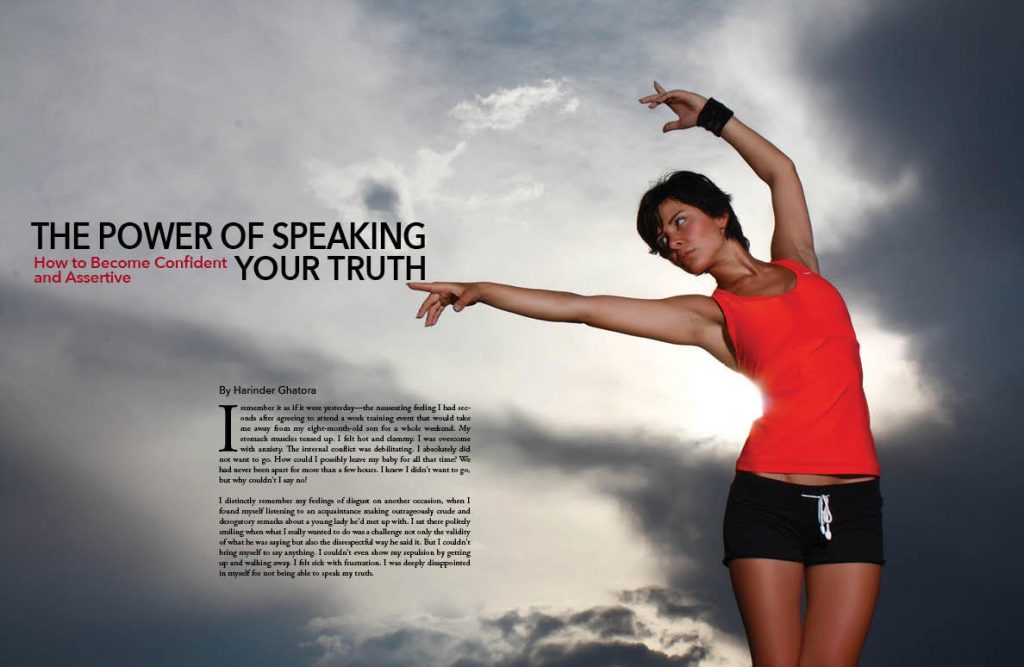How to Become Confident and Assertive
By Harinder Ghatora
I remember it as if it were yesterday—the nauseating feeling I had seconds after agreeing to attend a work training event that would take me away from my eight-month-old son for a whole weekend. My stomach muscles tensed up. I felt hot and clammy. I was overcome with anxiety. The internal conflict was debilitating. I absolutely did not want to go. How could I possibly leave my baby for all that time? We had never been apart for more than a few hours. I knew I didn’t want to go, but why couldn’t I say no?
I distinctly remember my feelings of disgust on another occasion, when I found myself listening to an acquaintance making outrageously crude and derogatory remarks about a young lady he’d met up with. I sat there politely smiling when what I really wanted to do was a challenge not only the validity of what he was saying but also the disrespectful way he said it. But I couldn’t bring myself to say anything. I couldn’t even show my repulsion by getting up and walking away. I felt sick with frustration. I was deeply disappointed in myself for not being able to speak my truth.
Since you’re reading this article, I’m guessing you’ve been there too, like so many of us. And you know exactly how it feels: that moment when someone in your life—a relative, co-worker, acquaintance, or even a stranger—expresses a view you vehemently disagree with. You know what it’s like to feel the tension, the irritation, and perhaps even the anger rising deep inside—the energy surging upwards, seeking some sort of verbal expression. You desperately want to put that person straight, correct him or her, and tell the person that he or she is wrong. But you can’t. The words just won’t come out. So, you stand there, silent.
Something stops you from opening your mouth. Something stops you from finding your voice. Something stops you from speaking your truth. And this happens again and again and again.
This situation and these feelings were once very familiar to me. I lived most of my young adult life in this way, never saying what I really wanted to say. I would outwardly agree with everyone around me, but inwardly I would be vehemently disagreeing; outwardly, I would be nice and polite, but inwardly I would struggle to control my emotional reactions to what others were saying or doing. On some occasions, the internal conflict was on an epic scale.
I would find phrases like “Sure, no problem …”; “No, it’s fine …”; and “Yes, of course …” coming out of my mouth in an instant—way before I had even given a second thought to what was being asked of me. More often than not, these phrases would be responses to situations that clearly were a problem, were not fine at all, and needed a “Sorry, but I can’t do that …” response.
I’m pleased to say that these experiences are now firmly in my past. I no longer choose to live my life in such a timid, compliant, and people-pleasing way. Over the years, I’ve learned to kindly, politely, but firmly state my truth. I still commonly say, “Sure, no problem …” and “No, it’s fine …” and “Yes, of course …” Now, these phrases come after a moment of true inner reflection on the situation in hand and my ability and willingness to comply. I can truly say that this is a far more healthy and harmonious way to live than the internal warfare that was previously raging inside me. To reach this place, I had to go on a deep inner journey. In this book, I would like to take you on this same journey of self-discovery and positive change.
I’m a qualified and experienced counselor and holistic life coach and have worked with hundreds of people in my private practice. Over the years, I’ve noticed that a common cause of direct and indirect unhappiness in many of my clients’ lives is their tendency not to speak their truth. When you cannot communicate your wishes and needs to those around you in a clear, firm, but polite way, it often means that at best, your needs are unmet, and at worst, you are misunderstood, ignored, or simply walked all over. Over many years, the internal tension that can build up has the potential to cause you severe mental and physical harm. It has the potential to warp your personality and wreck your relationships.
I chose to write this book for two reasons. Firstly, I believe that the simple practice of speaking your truth sits right at the heart of a happy, balanced, and fulfilled life. As human beings, we are all permanently in a relationship, firstly with ourselves, secondly with those around us, and thirdly with our environment. For every one of us, there is only ever one person at the center of our universe—ourselves. If we want to make meaningful connections with others, have closeness in our relationships, live a satisfying life, and have a strong, healthy, respectful sense of self. We must learn to identify and communicate what we truly feel, need, and expect from others.
The second reason is that through my client work, I have realized that many people are conditioned to believe that there are only two modes of expression: a passive, quiet, compliant way or a loud, angry, aggressive way. It is this “either/or” perception that I wish to challenge. There is another way—the middle way. My aim in writing this book is to present and promote this middle way, in which you speak your truth firmly but gently and kindly. This is an assertive way.
Because I have been on this journey of discovery and learning myself, I know that it can initially feel scary. Learning to be assertive is like learning a new language. In the beginning, it can feel daunting and require an extra degree of effort. But as you begin to understand how you came to lose your voice in the first place, start to reflect on and challenge the underlying beliefs that are working against you, and learn alternative ways of expressing yourself. In time, being assertive will become second nature. It may be not easy initially, but as with everything in life, the more you do it, the easier it gets.
Being assertive is about honoring and expressing your needs and desires in a way that is considerate of other people’s needs and desires. As you’ll discover in the next chapter, it does not mean getting your own way all the time. It’s certainly not about shouting, arguing, or using your voice to abuse others—that’s aggression, not assertiveness, and the two are entirely different. It’s about learning to put your needs alongside those of others and mindfully and confidently speaking up for yourself in a manner that respects everyone concerned.
Throughout the book, you’ll find references to five fictional characters who all struggle to be assertive in different situations in their lives. Aaron, Jasmine, Jay, Sharon, and Zara will help us explore the issues that get in the way of a person speaking his or her truth and how these can be overcome. We will be following their individual journeys as each of them rediscovers his or her voice and learns to move from passivity to assertiveness. I hope that as you read Aaron, Jasmine, Jay, Sharon, and Zara’s stories,
you’ll be able to reflect on your own experiences of not speaking your truth and gain some insight into what holds you back from expressing yourself truthfully. To aid this process, I’ve included a series of self-reflection exercises throughout the book. These have been designed to encourage you to think about and uncover the underlying causes and identify the thoughts and beliefs that underpin your passivity to move past it.
The way we think and the beliefs we hold profoundly influence the way we feel and the way we behave. A crucial part of the journey from passivity to assertiveness is identifying and working through the thoughts and beliefs that are keeping you locked into your passive behavior. This is something you’ll learn to do as you read on and work through the exercises, but for now, I want to point out that one of the most powerful ways to pinpoint your innermost beliefs is through journaling. Writing down your thoughts and feelings opens you up to and sheds light on your internal dialogue, which is challenging to do by merely thinking about an issue. For this reason, I strongly advise you to invest in a journal and make time to write down your thoughts in response to the self-reflection prompts included in this book.
If you can understand the core beliefs you hold, engage with the self-reflection questions in this book, work through the suggested exercises, and find the courage to try out the techniques shown in situations of your own choosing. At your own pace, you will find that gently, over time, you will have moved to that place of dignified, respectful, empowered expression that already exists somewhere deep inside of you.







